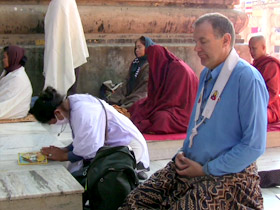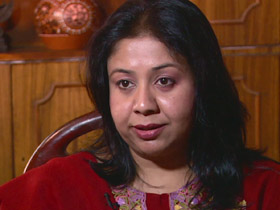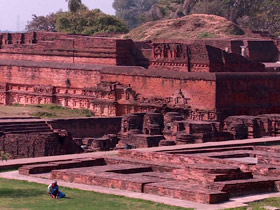FRED DE SAM LAZARO, correspondent: Only a tiny fraction of India's population is Buddhist, but its tourist ads and foreign policy tout India's Buddhist heritage, beckoning visitors to the land where one of the world's oldest belief systems took root 2,500 years ago.
The ancient city of Bodh Gaya is one of Buddhism's holiest locations. Once past the street entertainers, panhandlers and trinket salesmen, pilgrims enter the imposing Mahabodhi Temple.
VEN BHIKU CHALINDA (Chief Monk): (through translator) We have people visiting from many Buddhist countries: Japan, Korea, Vietnam, Cambodia, Thailand. Most of our visitors are from Sri Lanka and Thailand.

DE SAM LAZARO: Devotees line up to enter and pray in the inner sanctum. They spend hours meditating just outside, under the ancient bodhi tree—a direct descendent of the one under which Buddhists believe Siddharth Gautama, the royal prince, also meditated as he embraced a life of asceticism and became enlightened.
SAMORN SRI (Thai pilgrim): I also would like to do the meditation here to discover myself, for my soul. And I believe this is the best place to do the meditation.
LAURENCE SHEPHARD (Canadian pilgrim): Buddhists believe that this is a very powerful place and anything that you do here is magnified, so any wishes you make for other people, any good wishes, any practice that you do, it’s increased. The power is increased. So for example you see people prostrating you know, going down, I’ve been doing this for a month and that’s a purification practice and it gets rid of pride and they believe it's much stronger to do it here.
DE SAM LAZARO: The arrival of pilgrims is part of a decades-long revival effort by India's government—beginning in the 1950s when Prime Minister Jawaharlal Nehru wanted to use Buddhism to ally Asian neighbors, many themselves coming out of colonialism and World War II.

RANJANA MUKHOPADHYAYA (Buddhism Scholar): So Nehru declares Bodh Gaya as an international city of Buddhism and he starts inviting Buddhist countries to come and establish their temples in Bodh Gaya.
DE SAM LAZARO: Today in Bodh Gaya, temples and guest houses from several majority Buddhist nations welcome compatriot pilgrims. Soon, the host country hopes, they'll be joined by scholars as well.
There's no more than a walled compound now, but beginning next year, a large campus will be built on this site in the eastern state of Bihar, a place that can still evoke the era of the Buddha. The new Nalanda will resurrect one of the world's oldest universities that once thrived just a few miles away.
Today tourists come to the ruins of the large residential campus of Nalanda that flourished more than 1,400 years ago, well before Cambridge, Oxford, and universities in the West were founded.
MUKHOPADHYAYA: It was not just teaching Buddhism. There was astronomy. Then they were teaching what you call even mathematics, carpentry, architecture, various other subjects were being taught so it was it had a very comprehensive multidisciplinary approach towards education. People were coming to Nalanda to study from Japan, China, Korea of course, and all other places.

DE SAM LAZARO: It's one way that Buddhism spread elsewhere in Asia. But in India it declined or was assimilated into Hinduism, as Hindu rulers—and later Muslim ones—replaced those who supported or embraced Buddhism. By the 12th century, Nalanda had fallen into ruin.
GOPA SABHARWAL (Vice Chancellor, Nalanda University): The decline of a university like Nalanda also saw a power shift in knowledge to the West because the decline of Nalanda coincides with the rise of the Western university and the Western system of knowledge and its transmission. And also follows and soon after, you had colonialism come in. Now there is a desire for people once again to discover their neighbors rather than only look towards the West.
DE SAM LAZARO: The new Nalanda is an attempt to revive the one-time pan-Asian partnership. Several nations—Japan, China, Thailand, and even Laos—have already chipped in with financial support. The first structure to go up will be the new Nalanda Library, a strong symbol from the ancient campus, funded by the government of Singapore.
SABHARWAL: They’re clearly inspired by the records from old Nalanda, which talk about these very tall library structures that were kissing the clouds. And you know the myth says that when the library was burned, it burned for many months. So I think in the whole Buddhist world that the story of the Nalanda library is a story that evokes a very strong response.
DE SAM LAZARO: The new campus will offer studies in comparative religion and history, as well as current issues ranging from agriculture to ecology. It hopes to draw scholars from both East and West for a vigorous exchange of ideas and debate, seeking knowledge and enlightenment in a secular and classically Buddhist setting.
For Religion & Ethics NewsWeekly, this is Fred de Sam Lazaro in Bihar, India.







